DHM’s most recent statewide survey in Oregon tested sentiments about the current quality of transportation infrastructure and Oregonians’ transportation priorities for the next ten years.
As we near the Oregon legislature’s special session beginning on August 29, which will focus on transportation funding, these findings can provide insights into what Oregonians hope to see.
Oregonians feel positively about their local transportation systems and identify other issues as more important.
The survey asked Oregonians how they would rate the current quality of the transportation system in their area, and 67% say it is good or excellent. Portland metro residents are particularly satisfied with the quality of their transportation system, with 76% rating it as good or excellent. Similarly, Democrats across the state are more satisfied with their local transportation system (75%).
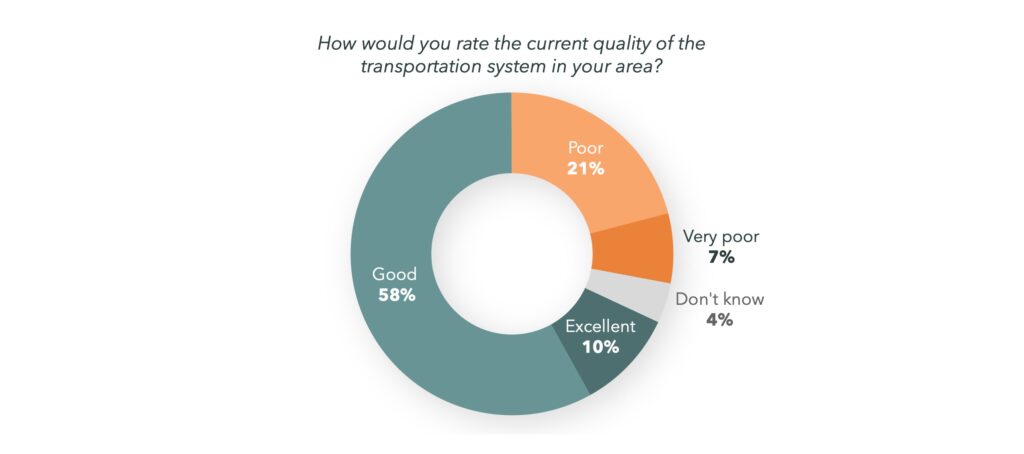
Transportation is not a top issue for Oregonians. When asked to identify the state’s most important problem, only 2% say something related to transportation. Rather, Oregonians most often mention homelessness (41%), followed by housing affordability (15%), drugs, addiction, or mental health (12%), and poor leadership or government mismanagement (12%).
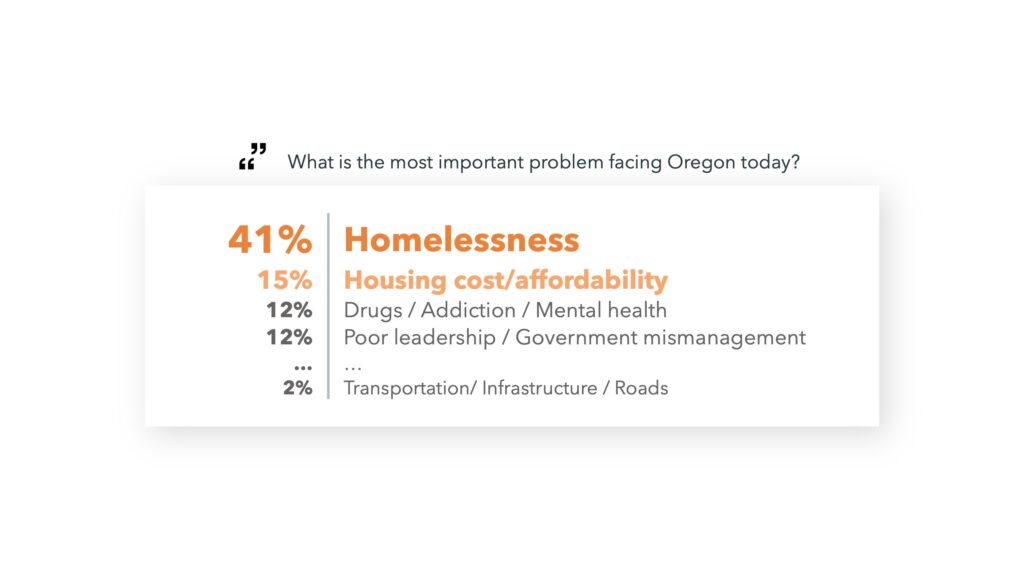
These factors—Oregonians being generally satisfied with transportation and not seeing it as a significant problem—speak to the challenges of passing a major transportation package, particularly one that increases taxes or attempts to make fundamental changes to the state’s funding model. It’s hard to ask voters and legislators to support big changes to things that people think are working well enough.
The top transportation priority for the next ten years is maintaining and preserving roads and highways.
Oregonians want funding allocated to maintaining and preserving existing roads and highways. When provided with a list of possible transportation priorities for the next ten years in Oregon and asked to think about transportation improvements that could be made in their area, a plurality of Oregonians (46%) say that maintaining and preserving existing roads and highways is the number one priority. This is the top priority across the state, at 44% for the Portland metro region, 48% for the Willamette Valley, and 47% for the rest. In addition, a strong majority of Oregonians (84%) identify maintaining and preserving our existing roads and highways as one of their top three priorities.
Maintaining the current infrastructure clearly overshadows other transportation priorities. The next highest priorities are investing in public transportation (18%) and building new roads and highways (15%). The lowest priorities relate to alternative modes of transportation: promoting alternative-fuel vehicles (hybrid and electric) and building an electric charging network (11%), and promoting active modes of transportation like bicycling or walking (10%).
At a time when Oregonians are generally satisfied with transportation, they want the state to prioritize the basics: maintaining the infrastructure we have.
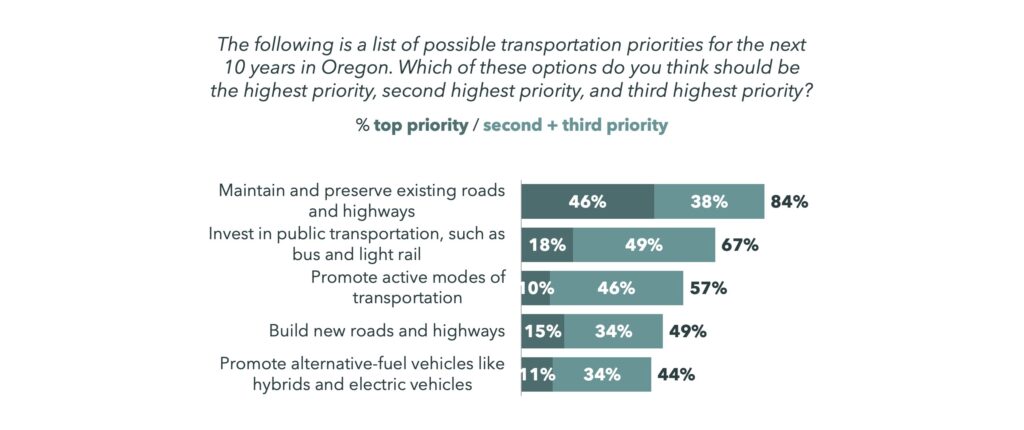
Most Oregonians oppose prohibiting new gas and diesel vehicles.
Oregon policy is that by 2035, all new passenger cars, SUVs, and light-duty trucks must be either all-electric or plug-in hybrid electric vehicles. In effect, this would prohibit the sale of traditional gasoline and diesel vehicles.
The majority (57%) of Oregonians oppose a state law prohibiting the sale of new gasoline and diesel vehicles by 2035. Opposition is consistent across the state, with 56% opposed in the Portland metro region, 57% opposed in the Willamette Valley, and 58% opposed across the rest of the state. Support is highest among Democrats (51% support), compared to Republicans (18% support) and non-affiliated voters (25% support).
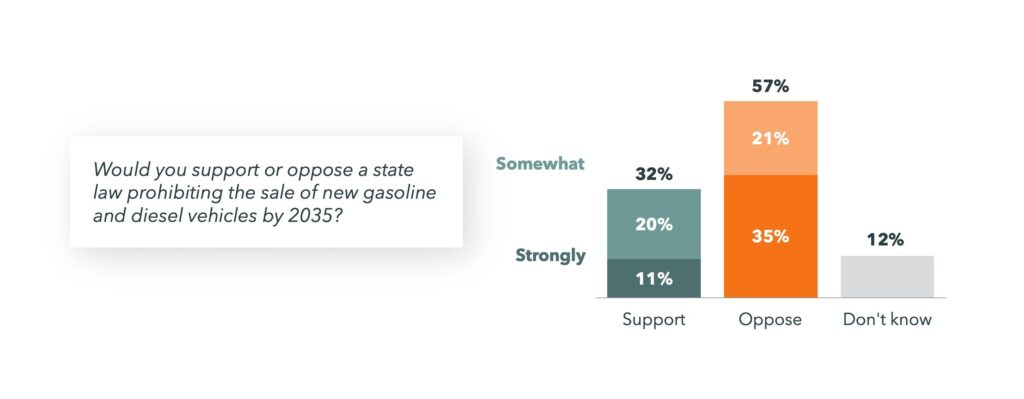
Oregonians are split on whether a road usage charge system could be an alternative to fuel taxes to fund the state’s transportation system.
An option for transportation revenue is a road usage charge. This would charge drivers based on the number of miles they drive, instead of paying a gas tax based on how many gallons of gas they purchase. Gas taxes are currently the largest source of transportation funding in the state. These funds help maintain Oregon’s roads, tunnels, and bridges. However, revenue from gas taxes is expected to fall because vehicles are becoming more fuel-efficient or run on electricity.
Half of Oregonians support road usage charges as an alternative way to fund maintenance of the state’s roads, tunnels, and bridges. Support is consistent across the state – 52% support in the Portland metro region, and 48% support in both the Willamette Valley and the rest of the state– but more favorable among Democrats (66% support) compared to among Republicans (44% support) and non-affiliated voters (42% support). Opposition (38%) is higher among older adults (47% opposed for 65+ and 44% opposed for ages 45-64) than younger adults (23% opposed for ages 18-29 and 36% opposed for 30-44).
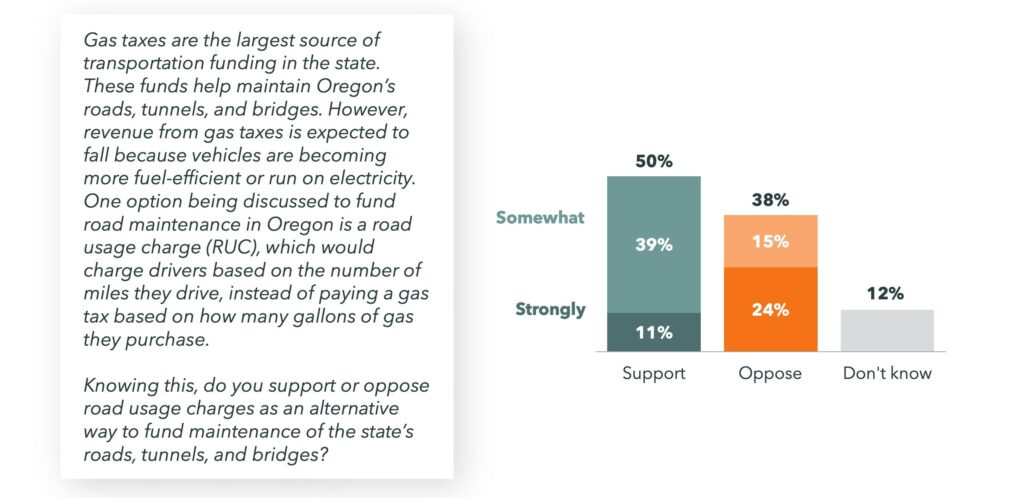
The bottom line
While transportation is not a top issue for Oregonians, there is a clear consensus on what matters most to them: maintaining and preserving existing roads and highways. This priority reflects how most Oregonians live and travel, and it is consistent across regions and political affiliations. At the same time, Oregonians generally oppose banning new gas and diesel vehicles in the next ten years, and they are ambivalent to road usage charges as a future funding solution.
Methodology
These findings come from a DHM Research online survey of 502 Oregon residents conducted from June 27 to July 3, 2025. Demographic quotas were set to ensure a representative sample, and data were weighted by age, gender, race, region, political party, education, and income level to ensure a representative sample. The margin of error for this survey is ±4.4%.
